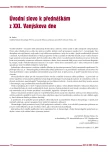Haemovigilance
Authors:
R. Procházková
Authors‘ workplace:
Transfuzní oddělení Krajské nemocnice Liberec, přednosta prim. MUDr. Renata Procházková
Published in:
Vnitř Lék 2005; 91(7 a 8): 913-917
Category:
128th Internal Medicine Day - 21rd Vanysek's Day Brno 2005
Overview
Haemovigilance is a system of actions, comprising detection, summary and analysis of information concerning severe adverse effects and events on the part of transfusion donors and recipients and epidemiological monitoring of blood donors. In the complex conception a clinical section, which means transfusion indication criteria, their control, good practice in the course of transfusion administration, is also included in the definition. System of reporting of adverse effects of transfusions, which depends on clinical doctors knowledge and approach, is of a key importance. Superior legislative, procedure standards, operable network connecting state authorities, health care providers and transfusion service, further unmistakable data collection definition and application of findings to the practice is necessary for the effective haemovigilance system. Legislative standard for the European Union member states is Directive No. 2002/98/EC, which provides quality and safety standards for production of transfusion preparations,it does not solve the clinical section of problems. In the Czech Republic, the field of transfusion preparations production is quite well handled by the Medicine Act, while European legislative being implemented gradually. The situation in the clinical section is not optimal, especially national guidelines for indications of transfusion preparations and transfusion administration itself are missing, the problem is also the absence of undergraduate and postgraduate education in transfusiology.
Key words:
haemovigilance – transfusion safety – adverse effect
Sources
1. Directive 2002/98/EC of the European Parliament and of the Council setting standard of quality and safety for the collection, testing, processing, storage and distribution of human blood and blood components and ammending Directive 2001/83/EC. Official J Eur Communities 2003.
2. Faber JC. Worldwide overview of existing haemovigilance systems. Transf Apher Sci 2004; 31 : 99-110.
3. Guide on the preparation, use and quality assurance of blood components. Reccomendation No. R (95) 15, 9th ed. Council of Europe, January 2003.
4. Robillard P, Chan P, Kleinman S. Hemovigilance for improvement of blood safety. Transf Apher Sci 2004; 31 : 95-98.
5. Zákon 79/1997 Sb. o léčivech a o změnách a doplnění některých souvisejících zákonů ve znění dalších novel.
6. Vyhl. MZdr. 411/2004 Sb., kterou se stanoví správná výrobní praxe, správná distribuční praxe a bližší podmínky povolování výroby a distribuce léčiv, včetně medikovaných krmiv a veterinárních autologních vakcín, změn vydaných povolení, jakož i bližší podmínky vydávání povolení k činnosti kontrolních laboratoří (vyhláška o výrobě a distribuci léčiv).
7. Zákon 123/2000 Sb. o zdravotnických prostředcích a o změně souvisejících zákonů.
8. Vyhl. 424/2004 Sb., kterou se stanoví činnosti zdravotnických pracovníků a jiných odborných pracovníků.
9. Ciavarella DJ, Harmening DM, Hoppe PA et al. Transfusion therapy: Clinical principles and practise. Bethesda: AABB Press 1999 : 359-361.
10. Procházková R, Masopust J. Návrh hlášení a vyšetření potransfuzních reakcí. Sborník abstrakt. 10. pracovní dny Společnosti pro transf. lékařství ČLS JEP, 8.-10. 9. 2004, Rožnov pod Radhoštěm.
Labels
Diabetology Endocrinology Internal medicineArticle was published in
Internal Medicine

2005 Issue 7 a 8
Most read in this issue
- Post transfusion reactions
- Thrombocytosis and thrombocythemia
- Antiphospholipid syndrome – diagnosis and treatment
- Antiaggregant therapy
